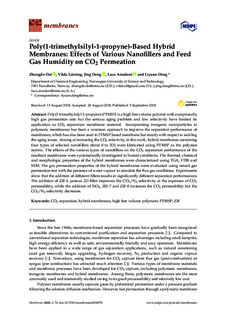| dc.contributor.author | Dai, Zhongde | |
| dc.contributor.author | Løining, Vilde | |
| dc.contributor.author | Deng, Jing | |
| dc.contributor.author | Ansaloni, Luca | |
| dc.contributor.author | Deng, Liyuan | |
| dc.date.accessioned | 2019-03-18T08:33:38Z | |
| dc.date.available | 2019-03-18T08:33:38Z | |
| dc.date.created | 2018-09-17T14:37:29Z | |
| dc.date.issued | 2018 | |
| dc.identifier.issn | 2077-0375 | |
| dc.identifier.uri | http://hdl.handle.net/11250/2590388 | |
| dc.description.abstract | Poly(1-trimethylsilyl-1-propyne) (PTMSP) is a high free volume polymer with exceptionally high gas permeation rate but the serious aging problem and low selectivity have limited its application as CO2 separation membrane material. Incorporating inorganic nanoparticles in polymeric membranes has been a common approach to improve the separation performance of membranes, which has also been used in PTMSP based membrane but mostly with respect to tackling the aging issues. Aiming at increasing the CO2 selectivity, in this work, hybrid membranes containing four types of selected nanofillers (from 0 to 3D) were fabricated using PTMSP as the polymer matrix. The effects of the various types of nanofillers on the CO2 separation performance of the resultant membranes were systematically investigated in humid conditions. The thermal, chemical and morphologic properties of the hybrid membranes were characterized using TGA, FTIR and SEM. The gas permeation properties of the hybrid membranes were evaluated using mixed gas permeation test with the presence of water vapour to simulate the flue gas conditions. Experiments show that the addition of different fillers results in significantly different separation performances; The addition of ZIF-L porous 2D filler improves the CO2/N2 selectivity at the expenses of CO2 permeability, while the addition of TiO2, ZIF-7 and ZIF-8 increases the CO2 permeability but the CO2/N2 selectivity decreases. | nb_NO |
| dc.language.iso | eng | nb_NO |
| dc.publisher | MDPI | nb_NO |
| dc.rights | Navngivelse 4.0 Internasjonal | * |
| dc.rights.uri | http://creativecommons.org/licenses/by/4.0/deed.no | * |
| dc.title | Poly(1-trimethylsilyl-1-propyne)-Based Hybrid Membranes: Effects of Various Nanofillers and Feed Gas Humidity on CO2 Permeation | nb_NO |
| dc.type | Journal article | nb_NO |
| dc.type | Peer reviewed | nb_NO |
| dc.description.version | publishedVersion | nb_NO |
| dc.source.volume | 8 | nb_NO |
| dc.source.journal | Membranes | nb_NO |
| dc.source.issue | 3 | nb_NO |
| dc.identifier.doi | 10.3390/membranes8030076 | |
| dc.identifier.cristin | 1610221 | |
| dc.relation.project | EC/H2020/727734 | nb_NO |
| dc.description.localcode | © 2018 by the authors. Licensee MDPI, Basel, Switzerland. This article is an open access article distributed under the terms and conditions of the Creative Commons Attribution (CC BY) license (http://creativecommons.org/licenses/by/4.0/). | nb_NO |
| cristin.unitcode | 194,66,30,0 | |
| cristin.unitname | Institutt for kjemisk prosessteknologi | |
| cristin.ispublished | true | |
| cristin.fulltext | original | |
| cristin.qualitycode | 1 | |

